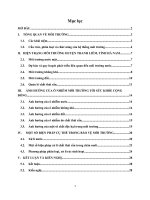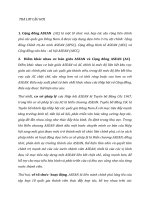ASEAN Community Cộng đồng Asean
Bạn đang xem bản rút gọn của tài liệu. Xem và tải ngay bản đầy đủ của tài liệu tại đây (2.48 MB, 30 trang )
Community
Main content
I.
Overview
II.
Why an ASEAN Community?
III. Fundamental principle
IV. Overview of the ASEAN Community
V. The Secretary of ASEAN
VI. Conclusion
ASEAN –
Asia’s Economic Powerhouse
A
A huge
huge market:
market: 625
625
GDP:
GDP:
FDI
FDI USD
USD 122
122
million+
million+ people
people
USD
USD 2.4
2.4 trillion
trillion
billion+
billion+
ASEAN
•
Highly connected: Physically,
Institutionally and among the
Peoples
•
Free trade agreements with major
regional economies
•
Young educated labor force
ASEAN…
DIVERSE
Home to major religions
Rich culture
Courtesy of ASEAN National Tourism Organisations
Vast natural
Courtesy of ASEAN National Tourism Organisations
resources
Courtesy of ASEAN National Tourism Organisations
ASEAN: Association of South East Asian Nations
10 MEMBER STATES
•
•
•
•
•
•
•
•
•
•
Brunei Darussalam(7January 1984)
Cambodia (30 April 1999)
Indonesia (8 August 1967)
Lao PDR (23 July 1997)
Malaysia (8 August 1967)
Myanmar (23 July 1997)
Philippines (8 August 1967)
Singapore (8 August 1967)
Thailand (8 August 1967)
Viet Nam (28 July 1995)
The ASEAN Journey to Community Building
2015
ASEAN Community
2007
Cebu Declaration
2003
Bali Concord II
1997
ASEAN Vision 2020
1967
Bangkok Declaration
The ASEAN Journey to Community Building
ASEAN Vision
2020
“ASEAN as a concert of Southeast Asian
nations, outward looking, living in peace,
stability and prosperity, bonded together in
partnership in dynamic development and in a
community of caring societies.”
1997
The ASEAN Journey to Community Building
Bali Concord II
“An ASEAN Community shall be established
comprising three pillars, namely political and
security cooperation, economic cooperation, and
socio-cultural cooperation…”
2003
The ASEAN Journey to Community Building
Strengthening Framework of ASEAN
Integration
ASEAN Charter
2008
Roadmap for an
ASEAN Community
2009–2015
2009
Master Plan on
ASEAN Connectivity
2010
The ASEAN Journey to Community Building
Coordination Mechanism of the ASEAN Integration
Why an ASEAN Community?
•
Need to intensify political cooperation, strengthen peace and security in Southeast Asia
•
Enhance economic competitiveness of individual Member States, and of ASEAN as regional market and
production base for global economic competition
•
Need to narrow the development gaps
•
Need to respond effectively to transnational threats to human security and new challenges in the 21
century
•
Harness human resources and benefit from rich cultural diversity in the ASEAN region
•
Gain international recognition and support for community-building
st
FUNDAMENTAL PRINCIPLES
-Mutual respect for the independence, sovereignty, equality, territorial integrity, and national identity of all
nations;
-The right of every State to lead its national existence free from external interference, subversion or
coercion
-Non-interference in the internal affairs of one another;
-Settlement of differences or disputes by peaceful manner;
-Renunciation of the threat or use of force; and Effective cooperation among themselves.
Overview of the ASEAN Community
•
ASEAN Political Security Community (APSC)
–
Ensures that the peoples and Member States of ASEAN live in peace with one another and with the world at large in a just, democratic and
harmonious environment.
•
ASEAN Economic Community (AEC)
–
Transforms ASEAN into a stable, prosperous, and highly competitive region with equitable economic development, and reduced poverty
and socio-economic disparities.
•
ASEAN Socio-Cultural Community (ASCC)
–
Contributes to realising an ASEAN Community that is people-oriented and socially responsible with a view to achieving enduring
solidarity and unity among the peoples and Member States of ASEAN.
Narrowing the Development Gap (NDG)
Progressing together through cooperation in development.
The Community Building Milestones
ASEAN Political-Security Community
1.
Ensure that the peoples and Member States of ASEAN live in peace
with one another and with the world at large
2.
Strengthen the mutually beneficial relations between ASEAN and its
Dialogue Partners and friends.
3.
Maintains the centrality and proactive role of ASEAN in a regional
architecture that is open, transparent and inclusive, while
remaining actively engaged, forward-looking and nondiscriminatory
The Community Building Milestones
ASEAN Political-Security Community – Milestones
International recognition of the Treaty of Amity and Cooperation as a key
code of conduct for inter-state relations in the region has grown remarkably.
The TAC now has 32 High Contracting Parties.
The Community Building Milestones
ASEAN Economic Community
Establish ASEAN as:
18
The Community Building Milestones
AEC Key Achievements
•
Free flow of goods: The ASEAN Trade in Goods Agreement (ATIGA).
•
Free flow of services: The ASEAN Framework Agreement on Services (AFAS) and the Mutual
Recognition Arrangements.
•
Free flow of investment: The ASEAN Comprehensive Investment Agreement (ACIA) and the Protocol
to Amend the ACIA.
•
Freer flow of capital: Implementation of measures to further spur financial services liberalisation, capital
market development, and capital account liberalisation.
•
Free flow of skilled labour: The ASEAN Agreement on the Movement of Natural Persons and the
ASEAN Qualification Reference Framework (AQRF).
The Community Building Milestones
ASEAN SOCIO-CULTURAL COMMUNITY
1.
2.
Realising an ASEAN Community that is peopleoriented and socially responsible to achieve
enduring solidarity and unity among the peoples and
Member States of ASEAN.
Forming a common identity and build a caring and
sharing society which is inclusive and where the
well-being, livelihood, and welfare of the peoples are
enhanced.
The Community Building Milestones
ASEAN SOCIO-CULTURAL COMMUNITY
Heightened Commitments
•
•
•
Declaration on Non-communicable Diseases in ASEAN
Declaration on Elimination of Violence Against Women and Elimination of Violence Against Children in ASEAN
Development of ASEAN instruments for the protection and promotion of the rights of migrant workers
The Community Building Milestones
ASEAN SOCIO-CULTURAL COMMUNITY
Quick, tangible action
Humanitarian assistance through the ASEAN Coordinating Centre for Humanitarian Assistance (AHA Centre)
ASCC Blueprint implementation rate: 97%
(as of December 2014)
Central Elements
•
•
•
•
Enhance and consolidate the ASEAN Community through deeper and more
comprehensive process of integration
Emphasis on centrality of ASEAN
Emphasis on integrated economies, equitable development of the ASEAN
Member States
Contain aspirational goals. One such goal is to halve the number of people
living in poverty in ASEAN countries and double the combined GDP of ASEAN
by 2030.
ASEAN Secretariat (ASEC)
•
•
•
•
Established on 24 February 1976 by the Foreign Ministers of ASEAN
Existing ASEAN Secretariat premises in Jakarta officiated in 1981
Staff recruited locally and from the ASEAN Member States
ASEC Vision: By 2015, ASEC will be the nerve centre of a strong and confident ASEAN Community that is
globally respected for acting in full compliance with its Charter and in the best interest of its people.
•
ASEC Mission: ASEC’s Mission is to initiate, facilitate and coordinate ASEAN stakeholder collaboration in
realising the purposes and principles of ASEAN as reflected in the ASEAN Charter.
ASEAN Secretariat’s Basic Function
Provide for greater efficiency in the coordination of ASEAN organs and for more effective implementation
of ASEAN projects and activities.









